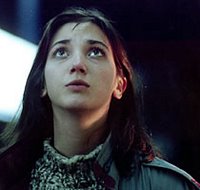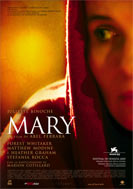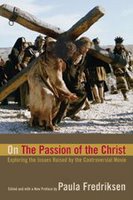First Episodes of the Living Christ Series
 As I mentioned in my post on episodes 4-7 of this series I decided to save the nativity episodes of this series until the end. Needless to say, if I had known I would find them as interesting as I did, I would have watched them first. As I happens I have watched these episodes twice as I lost my notes on my first viewing!
As I mentioned in my post on episodes 4-7 of this series I decided to save the nativity episodes of this series until the end. Needless to say, if I had known I would find them as interesting as I did, I would have watched them first. As I happens I have watched these episodes twice as I lost my notes on my first viewing!Unusually the film starts back in the Old Testament, with the story of Hezekiah and Sennacherib (2 Kings 18:17-19:37). The main point of this device seems to be to introduce the character of Isaiah (who also features in this story) who can then also deliver the prophecy from Isaiah 7:14 "The virgin will be with child and will give birth to a son, and will call him Immanuel". It also cleverly ties in this prophecy with an incident of God's intervention to bring about salvation of his people.
 The Old Testament story only lasts for the first half of episode 1, before the story shifts to the more familiar setting of Nazareth. There are two later films which also draw on the Old Testament. Roberto Rossellini's 1975 film Il Messia, also started with about 15 minutes of Old Testament footage, only this time looking at Saul's appointment as Israel's first king. Interestingly both films use relatively obscure stories from the bible as their prologue. The other film I was reminded of was The Passion of the Christ which starts with a quote from Isaiah. What really drew my attention was the way that Living Christ stated it's date as 701BC. Gibson's film quotes from (deutero)Isaiah, but dates it as 700BC - although apparently pre-release versions of the film dated it as 400BC.
The Old Testament story only lasts for the first half of episode 1, before the story shifts to the more familiar setting of Nazareth. There are two later films which also draw on the Old Testament. Roberto Rossellini's 1975 film Il Messia, also started with about 15 minutes of Old Testament footage, only this time looking at Saul's appointment as Israel's first king. Interestingly both films use relatively obscure stories from the bible as their prologue. The other film I was reminded of was The Passion of the Christ which starts with a quote from Isaiah. What really drew my attention was the way that Living Christ stated it's date as 701BC. Gibson's film quotes from (deutero)Isaiah, but dates it as 700BC - although apparently pre-release versions of the film dated it as 400BC. Anyway, here are the episode breakdowns, with verses assigned as detailed in the citation guide.
 Episode 1
Episode 1Hezekiah, Isaiah and Sennacherib (2 Kings 18 & 19)
Annuciation (Luke 1:26-38)
Mary visits Elizabeth (Luke 1:39-45)
Magnificat (Luke 1:46-56)
Joseph's dream (Matt 1:18-25)
Journey to Bethlehem & birth (Luke 2:1-7)
Shepherds and the Angels (Luke 2:8-20)
Episode 2
Simeon and Anna (Luke 2:21-40)
Visit of the Magi (Matt 2:1-12)
Slaughter of the Innocents (Matt 2:14-15)
Joseph's Dream (Matt 2:13)
Escape to Egypt (Matt 2:16-18)
Episode 3
Return to Nazareth (Matt 2:19-23)
Boy Jesus in the Temple (Luke 2:41-52)
(Pilate's Installation as Govenor)
John the Baptist (Mark 1:1-8)
(Pilate and Herod plot against John)
(Jesus as a Carpenter)
Jesus' baptism (Mark 1:9-12)
A few notes
 The film-makers make a wise decision in keeping the angels off screen in this story. This both subjectivizes the encounter - we know something has happened but whether anyone else would see it is left to interpretation - and avoids tacky depictions of the angels which would detract from the overall story. The various dreams etc. are represented in a similar way. Futhermore, when Jesus is baptised we hear no voice from heaven nor, do we see a dove, but the camera pans up to the sky - leaving the viewer to fill in the gaps, and again suggesting that Jesus heard something else. (In fact we don't even see actually get baptised, which means the film skillfully sidesteps the question of the degree of immersion).
The film-makers make a wise decision in keeping the angels off screen in this story. This both subjectivizes the encounter - we know something has happened but whether anyone else would see it is left to interpretation - and avoids tacky depictions of the angels which would detract from the overall story. The various dreams etc. are represented in a similar way. Futhermore, when Jesus is baptised we hear no voice from heaven nor, do we see a dove, but the camera pans up to the sky - leaving the viewer to fill in the gaps, and again suggesting that Jesus heard something else. (In fact we don't even see actually get baptised, which means the film skillfully sidesteps the question of the degree of immersion).These three episodes really emphasize the Jewishness of Jesus - again, compared to the other Jesus films of this time, this film stands out in this respect (see my comments on the passion narratives). So episode 1 commences the whole series by putting it in the context of Jewish history, episode 2 shows the circumcision ceremony, and sets up the context around Jesus' Bar Mitzvah. Finally episode 3 shows Mary explaining the significance of the Mezuzah on their door posts.
This film is the only one I can think of that shows the wise men visiting Jesus whilst they are in a house as in Matthew's Gospel as opposed to the "stable" where the shepherds visit him in Luke. It is clear that Mary and Joseph have stayed on in Bethlehem for sometime after the census, and Joseph has started work as a carpenter. We also see Jesus working as a carpenter in episode 3 before he begins his ministry. Again one of the few films to really do something similar is Rosselini's.
Finally, episode 3 introduces us to Pontius Pilate as he is installed as governor. One piece of dialogue was where he specifically states "I'm no soul searching philosopher". Again many of the charges of anti-Semitism against The Passion of the Christ have been routed in the way that film portrays Pilate precisely as a "soul searching philosopher" (numerous authors use those very words.

































